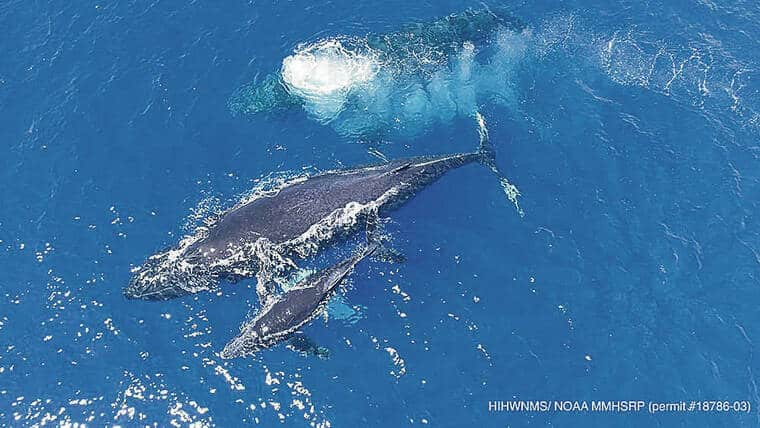
Humpback whale mother and calf swim in Hawaii’s ocean waters. (Photo: NOAA)
The sun-kissed waters surrounding Hawaii’s picturesque islands hold a secret that captivates locals and tourists alike — the awe-inspiring presence of humpback whales.
As the winter chill descends upon the northern hemisphere, these gentle giants embark on an epic journey to the warm embrace of Hawaii’s tropical seas. Join us on a mesmerizing adventure as we delve into the enchanting world of humpback whales, exploring their incredible migration, unique behaviors, and the profound impact they have on Hawaii’s ecosystem.
Humpback Whales’ Great Migration
Humpback whales, scientifically known as Megaptera novaeangliae, are true globetrotters.
Every year, they embark on one of the longest migration journeys of any mammal, covering thousands of miles from their feeding grounds in cold, nutrient-rich polar regions to the warm waters surrounding the Hawaiian islands.
The annual pilgrimage is quite the spectacle, drawing thousands of visitors who eagerly await the opportunity to witness these magnificent creatures up close.
Why do Humpback Whales Head to Hawaii?
The waters surrounding Hawaii serve as the perfect winter destination for humpback whales.
The warm, shallow seas provide an ideal environment for giving birth and nursing their young calves. The calving grounds offer protection from natural predators, making it a safe haven for the newborns during their most vulnerable stages of life.
Humpback Whale Courtship and Song
Once in Hawaii, the humpbacks engage in fascinating courtship rituals that include breaching, tail slapping, and an intricate vocal display.
The males compete fiercely for the attention of females through acrobatic displays, launching their colossal bodies out of the water and creating enormous splashes. However, it is their enchanting songs that truly captivate the hearts of those who have the privilege of hearing them.
Humpback whales are renowned for their melodious tunes, believed to be one of the most complex and evocative forms of communication in the animal kingdom. These hauntingly beautiful songs can travel for great distances, echoing across the ocean’s depths. Scientists are still decoding the purpose behind these vocalizations, but they are thought to play a significant role in mating rituals and establishing territory.
Preserving Hawaii’s Ocean Giants
The presence of humpback whales in Hawaii is not only a remarkable natural wonder but also a poignant reminder of the interconnectedness of our planet’s ecosystems. The whales’ annual migration highlights the importance of preserving both their breeding and feeding grounds to ensure the continuity of their species.
Thankfully, conservation efforts in Hawaii have been instrumental in protecting these magnificent creatures.
RELATED: Learn more about how you can help with humpback whale conservation efforts.
Whale-watching tours and water-based activities adhere to strict guidelines to prevent disturbances and maintain a safe distance from the whales, ensuring their natural behaviors are not disrupted. Additionally, local organizations work tirelessly to educate the public about the critical role humpback whales play in maintaining a balanced marine environment.
Humpback whales are not only guardians of the oceans but also ambassadors of awareness, inspiring people around the world to take action against threats such as climate change, ocean pollution, and ship strikes. Through collective efforts, we can secure a brighter future for these incredible giants of the sea.
More Whales in Hawaii’s Waters
Humpback whales are not the only whales that can be found in Hawaii’s waters. Several other whale species can also be spotted in Hawaiian waters throughout the year.
Hawaii’s warm and nutrient-rich waters make it a diverse and rich habitat for various marine life, including different species of whales.
Some of the other whale species that can be found in Hawaii’s waters include:
Sperm Whales: Sperm whales are deep-diving whales and are often seen in the offshore waters of Hawaii. They are the largest toothed whales and are known for their distinctive square-shaped heads and impressive diving abilities.
Bryde’s Whales: Bryde’s whales are relatively common in Hawaiian waters, particularly around the main islands. They are medium-sized baleen whales and are often observed feeding on small fish and krill.
Pilot Whales: Pilot whales, both short-finned and long-finned, can occasionally be spotted in the deeper waters of Hawaii. These social and highly vocal whales tend to travel in large pods.
Melon-Headed Whales: Despite their name, melon-headed whales are actually a species of oceanic dolphin. They are occasionally seen in Hawaiian waters and are known for their playful behavior.
Killer Whales (Orca): Although not as common as the other species mentioned, there have been occasional sightings of killer whales in Hawaii’s waters. These apex predators are known for their intelligence and complex social structures.
Cuvier’s Beaked Whales: Cuvier’s beaked whales are deep-diving whales that can be found in offshore waters. They are elusive and not often seen, but they are present in the region.





